40 Taiwanese foods we can't live without

Salted Goose (�水鹅) the taste of the oldies of Taiwanese, try the most famous salted goose in Taipei. No regrets.
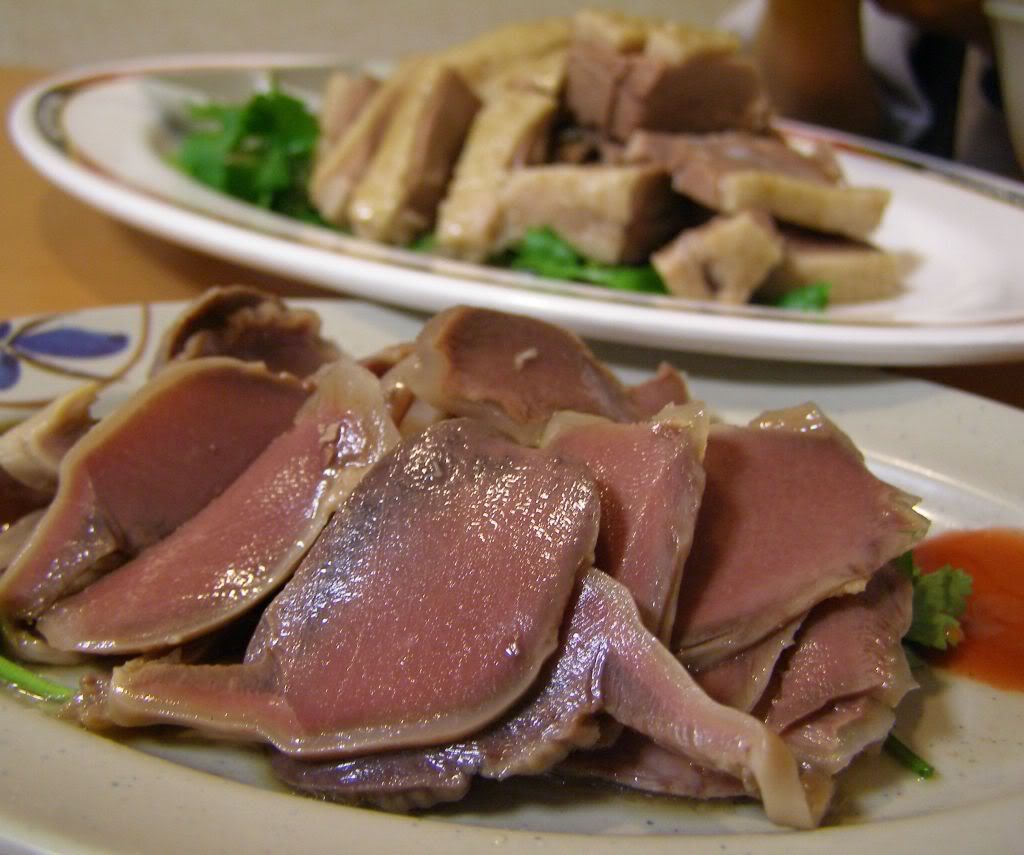


Small eats are the big thing in Taiwan where the philosophy is eat often and eat well.
Sure, there's the internationally accepted three-meals-a-day format of dining, but why be so limited when you can make like the Taiwanese and do some gourmet snacking at any time of the day, all day, every day?
The capital Taipei has around 20 streets dedicated to snacking.
Every time you think you've found the best streetside bao, the most incredible stinky tofu stand or mind-blowing beef noodle soup, there's always another one that surpasses it.
Taiwanese food is a mash-up of the cuisines of Min Nan, Teochew and Hokkien Chinese communities, as well as Japanese cuisine.
The results of these culinary marriages are diversely delicious.
When we asked some Taiwanese friends about the best food on their island, the argument that ensued almost broke up life-long friendships.
"We almost had a war -- we just have too many good eats," was the typical reply.
Food: it's serious, it's respected, it's all excellent in Taiwan.
 Not to be underestimated: braised fatty pork with rice.
Not to be underestimated: braised fatty pork with rice.
A Taiwanese saying goes, "Where there is a wisp of smoke from the kitchen chimney, there will be lurou fan" (braised pork with rice). The popularity of this humble dish cannot be overstated.
"Lurou fan" is synonymous with Taiwan.
The Taipei city government launched a "braised pork rice is ours" campaign last year after Michelin’s Green Guide Taiwan claimed that the dish is from Shandong Province in mainland China.
A good bowl of lurou fan has finely chopped, not quite minced, pork belly, slow-cooked in aromatic soy sauce with five spices. There should be an ample amount of fattiness, in which lies the magic.
The meat is spooned over hot rice.
A little sweet, a little salty, the braised pork rice is comfort food perfected.
Jin Feng Lu Rou Fan (金峰滷肉飯), 10 Roosevelt Road, Section 1, Jhongjheng District, Taipei City;
 Nothing like a good debate about beef noodles.
Nothing like a good debate about beef noodles.
You know it's an obsession when it gets its own festival.
Beef noodle soup is a dish that inspires competitiveness and innovation in chefs. Everyone wants to claim the title of beef noodle king.
From visiting Niu Ba Ba for one of the most expensive bowls of beef noodle soup in the world (TW$10,000, or US$334) to a serendipitous duck into the first makeshift noodle shack that you spot, it's almost impossible to have a bad beef noodle experience in Taiwan.
Lin Dong Fang's beef shanks with al dente noodles in a herbal soup are a perennial favorite. The streetside eatery’s secret weapon is the dollop of homemade chili-butter added last.
Lin Dong Fang (林�芳), 274 Bade Road, Section 2, Jhongshan District, Taipei City; ; Niu Ba Ba (牛爸爸), No. 16, Alley 27, Lane 216, Section 4 Zhongxiao Donglu, Da'an District, Taipei City; +886 2 2778 3075/
 The oyster omelet: the island's snack.
The oyster omelet: the island's snack.
Here's a snack that really showcases the fat of the land of Taiwan. You've got something from the sea and something from the soil.
The eggs are the perfect foil for the little oysters easily found around the island, while sweet potato starch is added to give the whole thing a gooey chewiness -- a signature Taiwan food texture.
No wonder it was voted best snack to represent the islandin a poll of 1,000 Taiwanese by Global Views Monthly in 2007.
Lai's Egg Oyster Omelet (賴記雞蛋蚵仔煎), Ningxia Road Night Market;
 Better than beer: bubble tea is a drink and a snack.
Better than beer: bubble tea is a drink and a snack.
Bubble tea is representative of the "QQ" food texture that Taiwanese love. The cute-sounding phrase refers to something that is very chewy, just like the tapioca balls that are the "bubbles" in bubble tea.
It is said that this unique drink was invented out of boredom. Liu Han-Chieh threw some sweetened tapioca pudding into her iced Assam tea on a fateful day in 1988 and one of the greatest Taiwanese exports was born.
Huge variations on the theme have since emerged, including taro-flavored tea, jasmine tea or coffee, served cold or hot.
Chun Shui Tang teahouse (æ˜¥æ°´å ‚), 48 Yi-shu St., Longjing, Taichung County;
More on CNNGo: Is this the inventor of bubble tea?
 If the Addams Family came to Taiwan.
If the Addams Family came to Taiwan.
This Tainan specialty is a mutated offspring of French toast and chowder.
An extra thick piece of bread is hollowed out to resemble a flat bread bowl. It is toasted to harden it and then filled with seafood chowder.
Legend says a Taiwanese chef who studied Western cooking invented this bread-soup-bowl-with-corners.
One day an archeologist tried the toast and told the chef, “It looks just like the coffin I am excavating now.”
Thus, the chowder soup took on its morbid Chinese name, which means "coffin bread."
赤å´�棺æ��æ�¿ (Chìkàn GuÄ�ncai BÇŽn), No. 180, Kangle Market, West Central District, Táinán; ; guan-tsai-ban.com.tw
 Thankfully, we no longer have to wait for the slack season to eat this.
Thankfully, we no longer have to wait for the slack season to eat this.
You've gotta love a place called Slack Season and it's the first pit stop on any trip to Taiwan.
The iconic eatery originated in Tainan about a century ago. A fisherman sold noodles during the slack season and the joint became so successful that he quit fishing altogether.
The signature bowl of Slack Season noodles is served in shrimp soup with bean sprouts, coriander, minced pork and fresh shrimps.
This bowl of comforting flavors is so addictive that a man from Tainan ate 18 bowls in a row, according to Slack Season.
Slack Season Tainan Main Store (度�月), 16 Jhongjheng Road, Tainan City; , as well as various locations, see website for more details: www.iddi.com.tw
 Pan-fried buns, bigger and better in Taiwan.
Pan-fried buns, bigger and better in Taiwan.
Do you like the fluffiness of cake as well as the crunchiness of potato chips? The pan-fried bun gives you the best of both worlds.
These buns are made with spongy white Chinese bread that are pan-fried on the bottom. Break them open to reveal the moist porky filling.
A Shanghainese staple, the Taiwanese version differs in two ways: it is slightly bigger in size and it hits the pan upside-down.
Hsu Ji (許記), Shida Night Market, Taan District, Taipei City;
 Dear Gua Bao, you're the Big Mac of our eye.
Dear Gua Bao, you're the Big Mac of our eye.
It's a hamburger, Taiwan-style.
A steamed bun sandwiches a hearty filling of braised pork belly, pickled Chinese cabbage and powdered peanuts.
The filling is chopped up into small pieces and mixed together so there's a bit of everything in every bite. Consider doing this with Western hamburgers.
Take in a big mouthful and enjoy the salty, sour and sweet flavors and the greasy pork swimming in your mouth.
Lan Jia Gua Bao (�家割包), No. 3, Alley 8, Lane 316, Section 3, Roosevelt Road, Taipei City;
 Urban legend says you can play ping-pong with iron eggs.
Urban legend says you can play ping-pong with iron eggs.
It's called the "iron egg" because this mini egg is tough as nails. With a rubbery consistency these chewy eggs dyed black from long-braising in soy sauce, are a highly addictive delicacy in Taiwan.
Often made from quails' eggs, the little balls are cooked for hours in soy sauce then air-dried. The whole process is repeated over several days until the protein becomes tough and acquires the desired amount of chew.
Seaside A-Po (海邊阿婆), 151-1, Jhongjheng Road, Tamshui; A-Po (阿婆), 135-1, Jhongjheng Road, Tamshui
 SunnyHill's traditional pineapple cake.
SunnyHill's traditional pineapple cake.
This iconic Taiwanese pastry is one of the best souvenir options. These mini pineapple pies are filled with candied pineapple.
If you want the best pineapple cake experience, try SunnyHills which uses only local pineapple as filling. It yields a darker filling, rougher texture and a more sour taste.
The traditional pies at other shops are filled with a mix of pineapple and chewable bits of winter melon. They have a fruity sweetness and a golden casing of crumbly buttery pastry.
Stores that replace pineapple completely with winter melon to cut costs are committing a big no-no.
SunnyHills (微熱山丘), 1/F, No. 1, Alley 4, Lane 36, Section 5, Minsheng East Riad, Songshan District, Taipei City; ; www.sunnyhills.com.tw
 Don't waste a single drop: water down the brown sauce and drink it up.
Don't waste a single drop: water down the brown sauce and drink it up.
Tian bu la refers to fish paste that has been molded into various shapes and sizes, deep-fried, then boiled in a broth. Before eating, the pieces of solid fish paste are taken out of the broth and smothered in brown sauce.
Doesn't sound like much, but it delivers plenty of the sweet flavors and chewy textures beloved by Taiwanese. Tian bu la is basically a Taiwan take on Japanese oden, with more sugariness, tougher fish cakes and a signature sauce.
After finishing the pieces of fish cakes, there's more to come. Get some soup from the vendor and add it to the remaining sauce in the bowl. Mix and drink the flavor bomb.
Simon Tian Bu La (賽門甜�辣), 95 Xining South Road, Wanhua District, Taipei City;
 Ba wan: dumplings for giants.
Ba wan: dumplings for giants.
The ba wan is Taiwan's mega dumpling.
Made with a dough of rice flour, corn starch and sweet potato starch, it looks almost translucent after cooking. Pork, veggies and sometimes eggs are stuffed inside and gravy is poured on top.
It is commonly believed that ba wan was invented during periods of scarcity. The simple pork dumpling was then a luxurious snack enjoyed only during the Lunar New Year festival.
Tonghua Bawan (通化肉圓), No. 7, Alley 39, Tonghua Street, Da'an District, Taipei City;
 Perfect street food: boneless and bite-sized.
Perfect street food: boneless and bite-sized.
In the fried chicken hall of fame, Taiwan deserves its own exhibit. Not only has it made the giant fried chicken cutlet (No. 35 on this list) a cult classic, but its popcorn chicken is dangerously addictive.
The chicken is chopped into bite-sized pieces, marinated, dipped in batter and deep-fried. A generous sprinkling of salt and pepper complete the morish morsels. It's a ubiquitous snack on the city streets.
Taiwan's First Popcorn Chicken Store(��第一家鹽酥雞創始總店), No. 530-1, Bei'an Road, Zhongshan District, Taipei City
 The flaky scallion pancake, Taiwan's food porn queen.
The flaky scallion pancake, Taiwan's food porn queen.
There is nothing more appetizing than the sight of a flaky scallion pancake being slowly torn apart. Add cheese and egg fillings to maximize the visuals.
Devour this night market staple in a few bites to ensure it is steaming hot and chewy.
Shida Night Market, Taipei City
 Oyster vermicelli: taste of the sea.
Oyster vermicelli: taste of the sea.
A bowl of great oyster vermicelli should have a thick, flavorful soup base while the thin rice noodles and oysters should still retain their distinct texture.
Some people will add chopped intestines for a funky dimension to the soup.
It is a gooey, slurpable dish, more soup than noodle, with an intense briny taste.
Ay-Chung (阿宗), 8-1 Emei St., Wanhua District, Taipei City;
 Oyster vermicelli: taste of the sea.
Oyster vermicelli: taste of the sea.
A bowl of great oyster vermicelli should have a thick, flavorful soup base while the thin rice noodles and oysters should still retain their distinct texture.
Some people will add chopped intestines for a funky dimension to the soup.
It is a gooey, slurpable dish, more soup than noodle, with an intense briny taste.
Ay-Chung (阿宗), 8-1 Emei St., Wanhua District, Taipei City;
 You need two hands to eat this, one to hold your nose.
You need two hands to eat this, one to hold your nose.
This is the world's best love-it-or-hate-it snack and Taiwan does it just right.
The "fragrant" cube of bean curd is deep-fried and draped with sweet and spicy sauce. It you hold your nose, it looks and tastes just like a plain ol' piece of fried tofu, with a crisp casing and soft center like pudding.
But what's the fun in eating that? Inhale deeply and relish the stench, the smellier, the better.
Raohe night market, Taipei
 "See, it has a perfect Taiwan shape."
"See, it has a perfect Taiwan shape."
Leaving taste, smell and nutritional value aside, the sweet potato stands out for one particular reason in Taiwan -- it is shaped like the island. For this, the sweet potato occupies a very special place in every Taiwanese heart.
Taiwan-grown sweet potatoes are added to soup with ginger, or roasted by street vendors in ovens converted from oil-drums, or ground to a flour and added to other dishes to give texture, or fried into sweet potato chips.
As long as the beloved root vegetable is in it, Taiwanese love it.
Also on CNNGo: Be a Taipei Sweet Potato Mama for a day
 Taiwan's summer blockbuster is the shaved ice mountain.
Taiwan's summer blockbuster is the shaved ice mountain.
One good thing about the hot, humid and stormy summers in Taiwan is the excuse to eat shaved ice mountain.
An oversized pile of shaved ice is heaped with fresh fruit and flavorings, such as mango pieces, juice and sweet condensed milk. It wins hands down just by looks alone.
A more traditional take is a smaller option, less dramatic but with freshly made mini rice balls.
Feast on mango shaved ice at Yong Kang 15 (永康15), 15 Yong-kang St., Taipei City; ; For classics go to Tai Yi Milk King (臺一牛奶大王), 82 Xin Sheng South Road, Section 3;
 So good that we ate half of it before remembering to take a photo.
So good that we ate half of it before remembering to take a photo.
The must-have at Rao He night market, the pepper cake is a crispy pocket filled with juicy pork that is infused with the aromatic bite of black pepper. Baked on the wall of a clay oven, the pies are a delicious ode to the pepper plant.
Make sure you get more than one, or risk the overwhelming sense of regret when you have to wait again in the long queue for more.
Raohe night market, Taipei
 Din Tai Fung: building an empire on a dollar-sized dumpling.
Din Tai Fung: building an empire on a dollar-sized dumpling.
Xiaolongbao may be a Shanghainese delicacy, but some argue that the Taiwanese perfected it. Taiwanese restaurant Din Tai Fung does its Shanghai comrades proud with their succulent pork soup dumplings.
Din Tai Fung’s bite-sized xiaolongbao have a consistently high quality. Their paper-thin wrappings hold rich hot broth and tender pork meatballs.
Gasps can be heard intermittently at Din Tai Fung as diners brave the scalding hot soup that squirts out upon biting the dumpling.
Din Tai Fung Dumpling House, 192 Xinyi Road, Section 2, Taipei City;
 Fishballs. Round things are just fun to eat.
Fishballs. Round things are just fun to eat.
What is better than fresh seafood? Why, fresh seafood made into balls, of course.
Look for handmade fish balls in Taiwan as the process incorporates more air into the ball thus allowing more broth to be soaked up. They also have a bouncier chew.
Jiaxing is a popular purveyor in Taipei best known for its specialty shark meat balls.
Jiaxing Fish Ball (佳興éšä¸¸), No. 21, Lane 210, Section 2, Yanping North Road, Datong District, Taipei City;
 Medicinal herbs gives us an excuse to feast on ribs.
Medicinal herbs gives us an excuse to feast on ribs.
This is Taiwan’s version of bak kut the, the Chinese meat soup that is also popular in Singapore and Malaysia.
In Taiwan, the soup is slow-cooked in Chinese medicine, extracting the essence from pork bones and more than 14 nutritious herbs, roots and dried fruits. It's yum and good for you too, especially for keeping warm in winter.
There isn't much meat on these lean bones, but the point of the dish is the soup. Don’t be shy to pick the bones up with your hands and suck the juices off them. In fact, it’s odd not to do so.
Nanya Night Market, Taipei City
 The whole goose and nothing but the goose on Taiwan's best tables.
The whole goose and nothing but the goose on Taiwan's best tables.
Geese, proudly bred on Taiwan farms, are never wasted. From the skin to the blood, they are made into delicious dishes.
The salted or smoked geese in Hou Yi are revelatory. Every bite of the juicy goose meat with slightly smoked goose skin is a celebration of poultry.
Or try one of Bistro Le Pont's bowls of steamed rice topped with goose, chili oil and x.o. sauce. The grains of rice are a vehicle for goose fat and flavor.
Hou Yi (後驛�肉), No. 29, Lane 220, Changan West Road, Datong District, Taipei City; ; Bistro Le Pont (樂朋�館), 176 Chaozhou St., Taipei City;
 Painting the wok with rice slurry to make ding bian cuo.
Painting the wok with rice slurry to make ding bian cuo.
Ding bian cuo is a bowl of slippery rice flour pasta.
Rice flour batter is poured along the side of a huge wok. It slides and spreads along the heated wok and forms slices of rice flour noodles.
When dried, the sheets will be cut into smaller pieces that become the very thin and very chewy noodles when cooked as ding bian cuo.
Wu Jia ding bian cuo is a century-old family business. Their ding bian cuo are served with handmade pork cakes, shrimp cakes, cabbage, daylily and bamboo shoots.
Wu Jia ding bian cuo (百年�家鼎邊趖), Keelung Temple Street Night Market, Taipei City
 Taiwanese hot dogs are made with sticky rice buns and cured sausages.
Taiwanese hot dogs are made with sticky rice buns and cured sausages.
Taiwanese pork sausage alone is a superstar at night markets, but when served as the snack "little sausage inside big sausage" it is unbeatable.
Basically, it's like a hot dog, but instead of a bun, sticky rice is stuffed inside a sausage casing to make an oversized rice sausage. That rice sausage is slit open to stuff in a pork sausage. So it's a little sausage inside a big one. Get it?
Fengjia Night Market, Taichung County
 Mobile mochi: get your chewy fix any time of the day.
Mobile mochi: get your chewy fix any time of the day.
These glutinous rice balls are soft as marshmallows and filled with sweet or salty things.
The most traditional mochi are filled with red bean paste and rolled in peanut powder. But in recent years, strawberry jam, sesame paste, green tea jam and peanut paste are some of the popular choices of filling.
You can learn how to make mochi by visiting the Royal Taiwan Mochi Museum (around US$5 per person).
Remember to chew carefully before swallowing, the sticky mochi are practically a choking hazard.
Royal Taiwan Mochi Museum(��麻糬主題館), No. 3, Tzu Qiang 3rd Road, Nantou County; , see the class schedule at www.taiwanmochi.com.tw (In Chinese only)
 Lantern Lu Wei doesn't worry about your schedule, only good flavor.
Lantern Lu Wei doesn't worry about your schedule, only good flavor.
No matter what you choose from the Lantern Lu Wei food stall, it will take on the taste of the signature five-spice soy sauce. It's a little sweet, not too salty and very aromatic with cloves, star anise, cinnamon and other spices.
Pick your preferred ingredients and the chef will cook it in the pot of special sauce. This makes a perfect light meal before a big night out.
Expect to wait in line as the chef never rushes but takes his time to allow the sauce to be well absorbed by the food.
Lantern Lu Wei (ç‡ˆç± æ»·å‘³), Shida Night Market, Taipei City
Originating in Taichung, the suncake is simply a flakey pastry filled with maltose. And yet this sweet nothing has come to represent Taichung City and is a souvenir sought out by all visitors.
Countless sun cake shops flourish in Taichung, all claiming to be the original store, which none of them are.
But maybe it's time for them to shine. The one and only original sun cake store Tai Yang Bakery closed down unexpectedly when the 68-year-old boss decided to retire.
Along Tze Yo Street, Zhongzheng District, Taichung County
 Sticky rice pudding the size of your stomach.
Sticky rice pudding the size of your stomach.
Sticky rice and Chinese mushrooms are fried with seasoning and stuffed into a bamboo tube together with pork and egg. The tube of rice is steamed again to further soften the texture until it becomes a cylindrical pudding.
Da Qiao Tou started making the rice pudding in a small stall under a bridge more than four decades ago. The business has expanded since but the rice pudding stays the same.
Be sure to add the homemade turnip-laced sweet spicy sauce to the pudding.
Da Qiao Tou (大橋é è€�牌ç’仔米糕), 41 Yanping North Road, Section 3, Datong District, Taipei City;
 Nothing like fried bread wrapped with roast bread to fuel a morning
Nothing like fried bread wrapped with roast bread to fuel a morning
Three elements to start a day right in Taiwan: sesame flat bread, deep-fried Chinese donut and soymilk.
Blogger Joan H from A Hungry Girl’s Guide to Taipei says her favorite breakfast is from Fu Hang.
“I love the thick sesame flat bread at Fu Hang because it has a slight sweetness, a thin crispy layer and soft center from coming straight out of the hot metal barrel. Many sesame flat breads are dry and flaky but Fu Hang's shows why there is often a half-hour to hour wait on the weekends.”
Fu Hang Dou Jiang (阜æ�豆漿), 2/F Hua Shan Market, 108 Zhongxiao East Road, Section 1, Taipei City;
This pudding is a mix of pig's blood and sticky rice and stuck on the end of a stick like a lollipop. For the final Taiwanese touch, the pudding is coated in a sweet peanut powder.
Basketball star Jeremy Lin Shu-How endorsed pig’s blood rice cake as one of his favorite snacks on his recent visit to Taiwan. If it is good enough for Lin, it is good enough for us.
Xiao Li (��), No. 1-3, Lane 136, Section 4, Roosevelt Road, Taipei City;
 Signature Taiwan: Three-cup chicken.
Signature Taiwan: Three-cup chicken.
Three-cup chicken is cooked in a cup of rice wine, a cup of oil and a cup of soy sauce. To this Taiwanese culinary triumvirate is added some fresh basil, chilies and garlic for an irresistible combination.
Some kitchens have a different definition of three-cup chicken, such as a cup of wine, a cup of sesame oil and a cup of sugar.
Old Taiwan (新��原味), 1 Mincheng 3rd Road, Gushan District, Kaohsiung; , www.oldtaiwan.com.tw
 Agei, an edible purse full of goodness.
Agei, an edible purse full of goodness.
Agei comes from the Japanese "aburaage" which are deep-fried tofu pockets.
These Taiwanese agei are stuffed with mung bean noodles and sealed off with fish paste. A typical sweet-spicy sauce completes it.
The tofu soaks up the soup its cooked in so each bite bursts with broth. Paired with a soy milk, the agei makes a great savory breakfast.
Zhenli Street, Tamshui
 Fen yuan, like sweet sticky marbles.
Fen yuan, like sweet sticky marbles.
Fen yuan refers to all the chewy dough that Taiwanese like to add to their dessert.
Sometimes they are made with sticky rice flour and various fillings. The dough is slightly translucent when steamed, revealing the colorful insides -- red bean, green tea, egg custard. They are just so joyful to look at.
Fen yuan is more commonly made from tapioca without filling. And when black sugar is added, it becomes the black pearls in bubble tea, called pearl fen yuan.
Raohe Night Market, Taipei City
 Almost as big as your face.
Almost as big as your face.
According to a Taipei Times’ report in 2011, Taiwanese devour more than 250,000 fried chicken cutlets each day.
If piled atop each other, they would make a chicken cutlet tower 10 times as tall as Taipei 101, the island’s tallest skyscraper at 508 meters.
Go to Hot-star for the original oversized chicken cutlet. The enormous slice of meat is as big as your face and very moist with a crispy crust. A generous coating of five-spice powder and pepper gives it a kick.
Starting as a small counter at Shilin night market, Hot-star is now a franchise present in Hong Kong, Malaysia and Singapore.
Hot-star Large Fried Chicken (豪大大雞扒), Shilin Night Market, see other locations
 Risotto in cuttlefish.
Risotto in cuttlefish.
Barbecued Taiwanese cuttlefish hits the spot every time. The island gets a lot of great cuttlefish and grill stations covered in cuttlefish skewers can be found everywhere in the southern tip.
Although a thick cuttlefish soup with herbs and veggies is a typical Taiwanese winter-warmer, the best way to enjoy the mollusks is fresh out of seawater, straight onto the charcoal grill.
Imagine the smoky aroma, dark grill marks, glistening furled edges and dustings of salt and pepper.
Fengjia Night Market, Taichung County
Very wobbly and hardly tasting of anything, the aiyu jelly takes on the flavor of whatever it is eaten with.
Add it to lemonade and shaved ice for a refreshing summer drink. The jelly gives the liquid a fun gloopy texture.
Shida Night Market, Taipei City
 Tasty and super cute, the croquette enslaves amateur food photographers.
Tasty and super cute, the croquette enslaves amateur food photographers.
Inspired by the Japanese deep-fried patty, korokke, and the French croquette, the ke le bing is now an indispensable snack in Taiwan.
Stuffed with mashed potato or minced meat, the disc-shaped croquette is coated with flour, eggs and breadcrumbs.
You can choose deep-fried meat, vegetables, seafood and anything else edible that can be molded into a disc shape. We love the pork and cheese combo the most.
Koroke (肉丸餅), 49-10 Emei St., Wanhua District, Taipei City
To describe it as the non-deep-fried version of a spring roll would be unfair, as "run bing" (steamed spring roll) was invented before the spring roll.
Every household has its own recipe for run bing. During festivals, families will gather at the table to have a run bing wrapping party. Each person chooses their own fillings from a buffet and rolls their own run bing.
Besides serving delicious run bing, Shin Yeh at Taipei 101 also offers an incomparable view of city.
Shin Yeh (欣葉), 85/F, Taipei 101, 7 Xinyi Road, Section 5, Xinyi District, Taipei City; , see other locations at www.shinyeh.com.tw
 Hot pot: best social activity.
Hot pot: best social activity.
Taiwanese are mad for spicy hot pot.
And who wouldn't be? The bubbling pots of broth are filled with all sorts of Chinese herbs and spices to create an incredibly rich flavor for all the raw, fresh ingredients that diners will dip into it.
New hot pot places pop up in Taiwan every day, each with a gimmick to attract insatiable hot pot diners.
There's all-you-can-eat hot pot and yakiniku served at the same table; there's bubble tea hotpot for the jaded.
But it is spicy hot pot with quality ingredients that stands the test of time. While Taiwan's spice-levels can't come close to Chongqing's, they're pretty piquant.
Head to perennial hot pot favorite and celeb-magnet Taihodien for a glam Taiwanese hot pot experience.
Taihodien can be found across Taiwan, see www.taihodien.com.tw for details; try bubble tea hotpot at Yue Yin Xuan, 80 Wenzhou St., Ta'an District, Taipei City
Some say Smoked Tea Goose is nice?
Some say, White salted goose original.is nice?
In Taipei.
But i tried all.
Yes, i tried it ...one word best.
http://the-aftertaste.blogspot.sg/2012/01/taipei-tian-mu-goose.html
No soy sauce type over there in Taipei.
This are Teochew kind.

Currently this also hardly you can find here.
Duck or Goose, you decided for yourself.
Don't get fooled by the vendors.
Come take alook alook what this street is offering you?
http://mykafkaesquelife.blogspot.sg/2010/05/snake-blood-in-taipei-taiwan.html
See we alway very carefull with our foods that we choice.
For Goose meat we will go for those with name and recommendation only.
In Hua Xi street like this stall.
After seeing those interesting activities the above link.

Next...from Jiufen.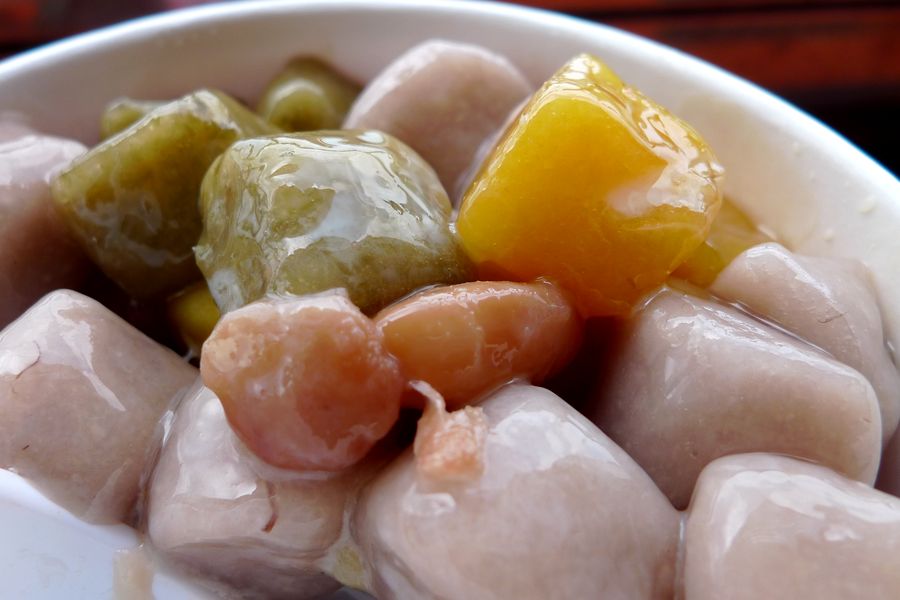
Over here there are a few stalls. so from the local informations that we gathered.
we were told , once entered the main entrance, the first stall on your right, just chiong.
No regrets.
from here.
Shop rating (A) clean enviroments,
Yes..products excellent.
Service good.
Sittng enviroment at the backyard, full views scenic..
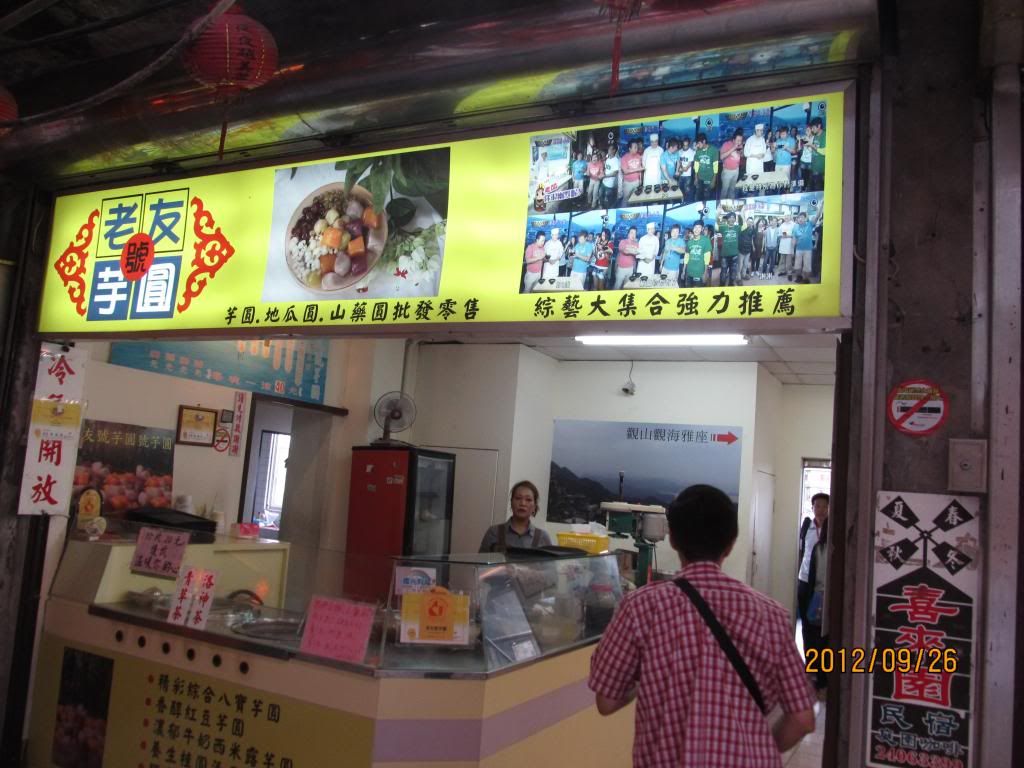
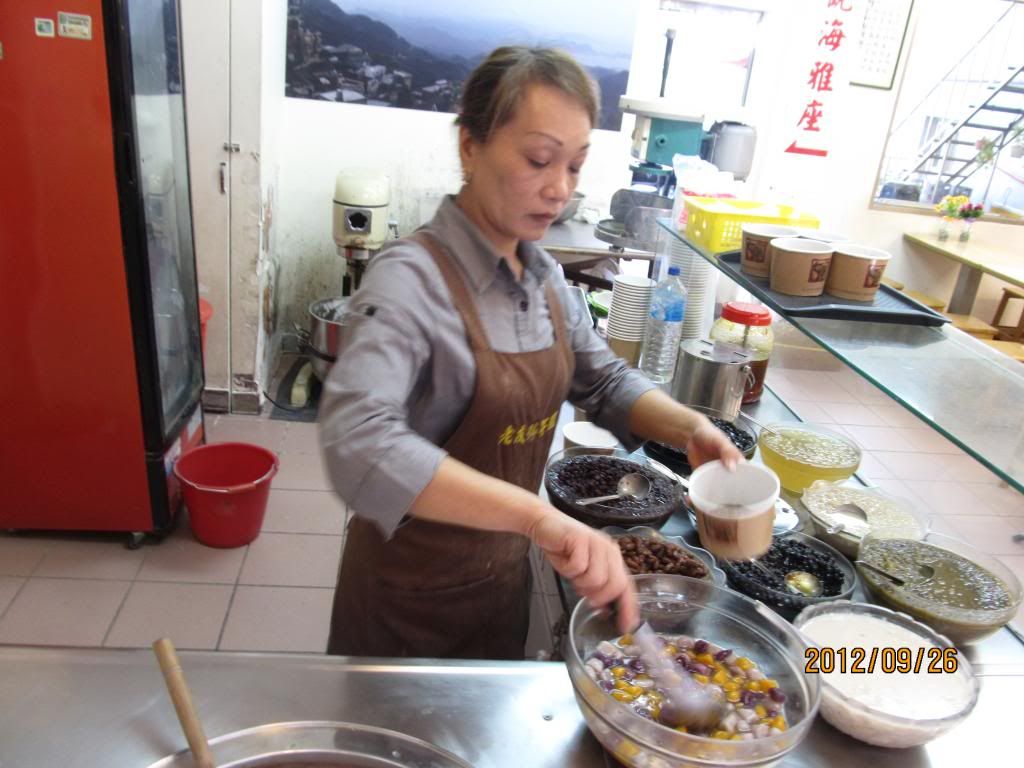
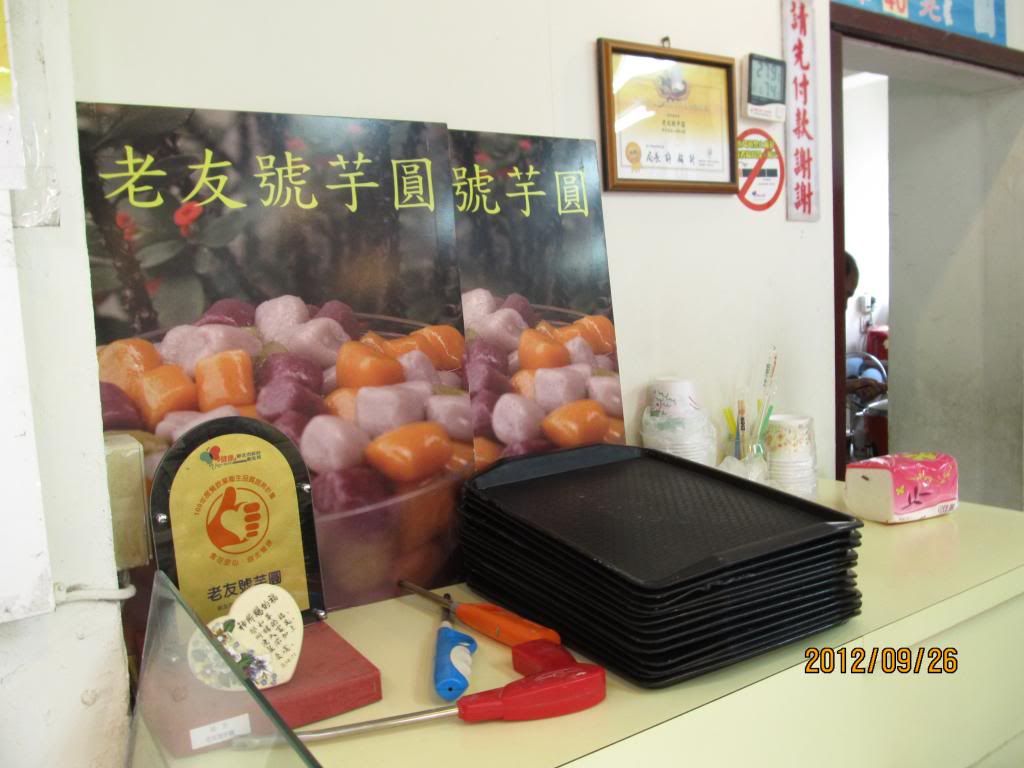
From this alley at your right.
No probelm you can try the others, not only this.
Everyones got their own choices.
Please dont listen to me.
I,could be wrong.
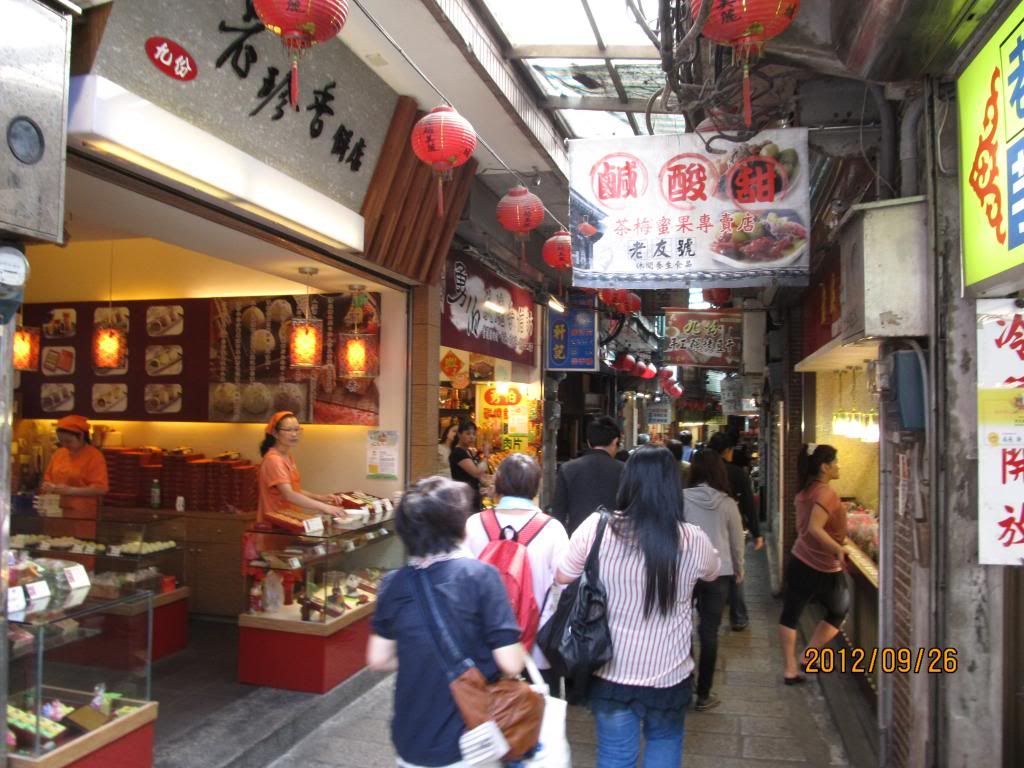
Sorry the best still come from here, this stall.
All my kakis also said.
Cause further inside we did tried another.
this bowl from the main entrance.

Some say this is the best over here in Jiufen.
.source
Another unique dessert found only in Jiufen, taro balls in sweet soup. Every bowl comes with a variety of taro ball flavours and you have the option of hot or chilled. Very nice texture and delicious. NT$50 a bowl. This is possibly the most famous food in Jiufen, and Grandma Lai is the most popular shop selling it.
賴阿婆芋圓 Grandma Lai’s Yuyuan (Taro Balls)
地�: 新北市瑞芳�基山街143號
Address: 143 Jishan St, Rueifang District, New Taipei City, Taiwan 224
AS i told not one, but a few further inside the alley.
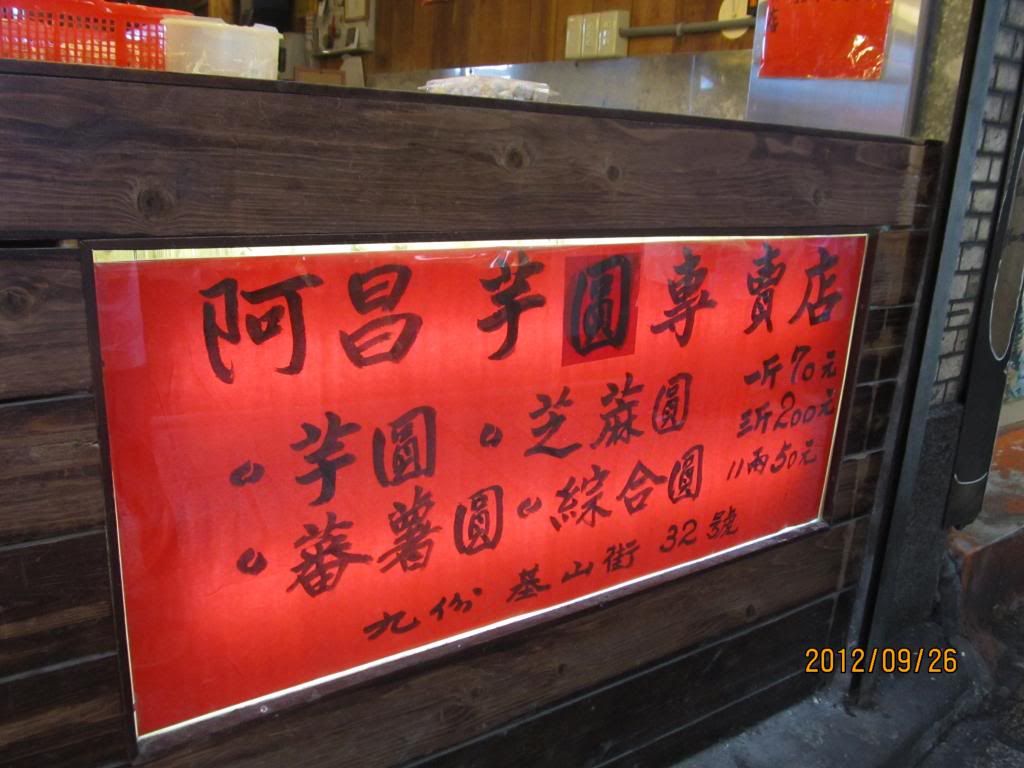
Like this ones factory scale type.
mass production, big.
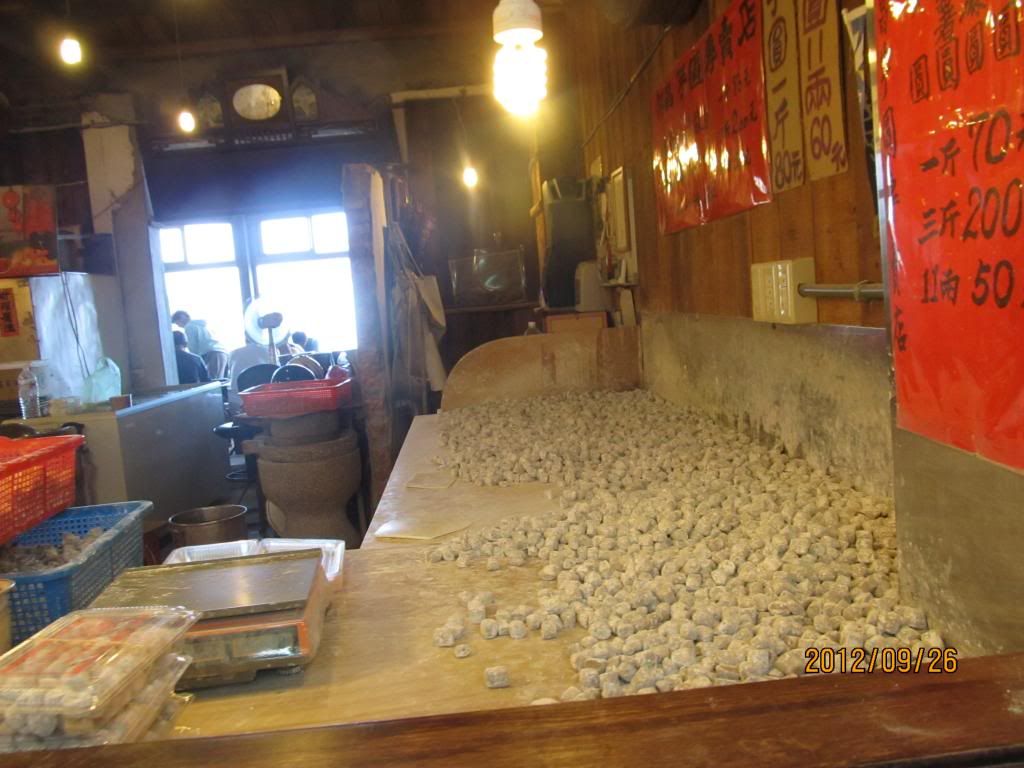
sourceOne of the foods Jiufen is most known for is taro balls, which is one of my favorite foods. They are chewy balls, similar to mochi, though it is made of potato flour and taro. It’s usually offered with other types of flavors like green tea and yams, creating an array of pretty colored balls. It’s usually served as a topping for shaved ice, in red bean soup, or sometimes in hot beverages.